So I went to see A Separation (Asghar Farhadi, 2011) tonight, and, like everyone I know who has seen it, I was completely enraptured. Indeed, even the over-cosmeticized quasi-senior citizens sitting a few rows over discussing ceramic tile patterns seemed to be enchanted by this beyond-outstanding piece of Iranian filmmaking.
A tense and provocative film, this story seems to increase in density the further you travel inward, without leaving you feeling too overwhelmed. While the main thrust of the film deals with a fairly standard familial drama (divorce), it gives birth to a web of heartache and agony that is so well-crafted that each blow hits you like an angel’s kiss- that is, if the angel was giving you really sad, complex, hand-wringing-style pecks! And if that wasn’t enough, Farhadi is also working with strong themes of religion, femininity, the legal system and, most importantly, childhood.
What fascinated me most within the film was his sensitivity towards characters who had little to no power of their own, yet were fully formed and explored people. Even if a character’s dialogue consisted of simply one or two words, the combined narrative and visual structure engendered a consistent and advanced sense of empathy. In particular, his highly attenuated depictions of children, young developing women, and the infirm seriously gave this film a higher sense of power and core stability. His use of lingering camera shots enhanced the relationship between the audience and the characters, pushing us into a deeper and more intimate relationship of our own with the film and each aspect of it.
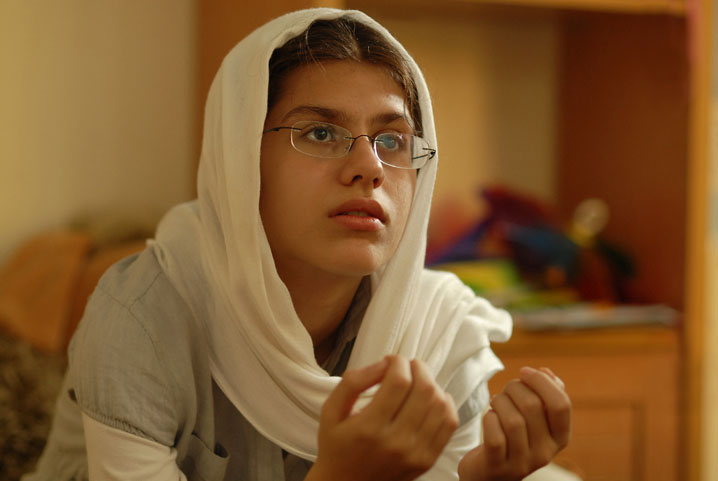
The character of Termeh is in a constant state of turmoil for most of the film, having to handle adolescence, her parents' relationship struggles, and her own decisions about where she fits in within all of it. While her father, Nader would argue against it (like many parents who engage in this type of behavior), he uses his daughter within power-play constructs, thus negating altruistic family motivations much of the time.
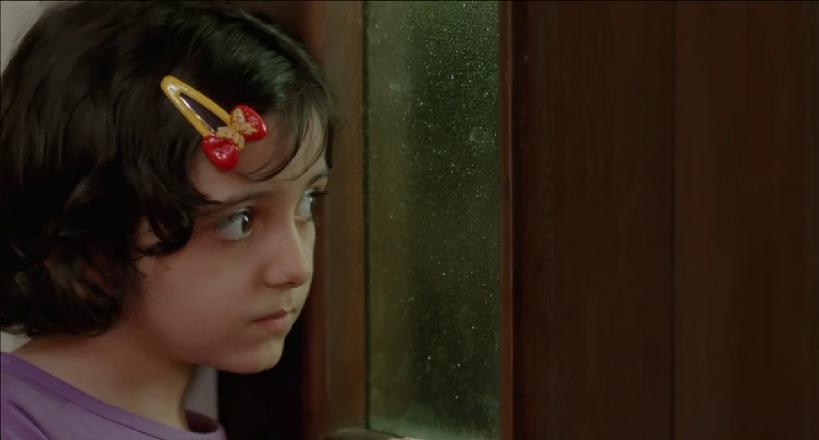
Because of her age, Somayeh is at an even clearer disadvantage. Beyond the fact that she is the "working woman's child," thus relegating her to an altogether different class, she must handle all the things that come with that identity: her unemployed and possibly abusive father, her very religiously-observant mother having to work and having to go with her to work, and being caught directly in the center of a terribly amount of adult issues that she is far too young to deal with. The continual shots of her face, her trusting demeanor and her inquisitive-but-shy glances only reify her position as The Innocent, in the film.
It is, however, the systematic visual returning to the “powerless” characters that make us feel that the film has established a kind of unspoken unity and communion. Indeed, within the narrative, they seem to be the only characters that are not constantly at war with one another, and they are pointedly shown communicating positively together, as in the scene where Termeh, Somayeh and Nader’s father are all participating in a foosball game and enjoying it together. Even though the other characters are around, they seem different somehow, like they are part of a different tribe. Cinematographer Mahmoud Kalari takes great care so as to depict these individuals that way and to make them stand out, even when surrounded. Within the larger diegesis, not only are these characters that have little to no say in what happens in their lives, but they are also the ones that we (the audience, the secret voyeurs) can look in upon and watch as they bond, getting closer and sticking together. They share that secret only with the audience. The rest of the characters are too busy with the drama. While everything else within this film is being pulled apart and “separated,” it is these things that are coming together: these budding relationships of the powerless.
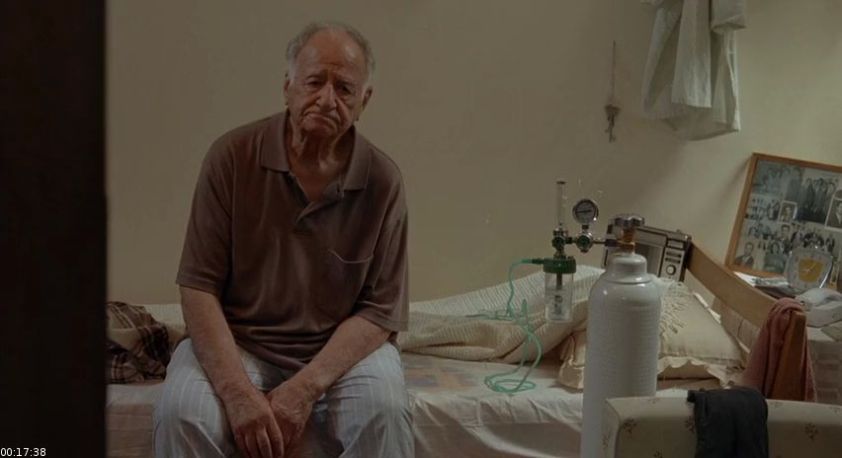
Nader's father has Alzheimer's and actually has less independent ability than either of the two children in the film. While he is an old man, he has shifted to the final stage of being an old man, which means that he mirrors the beginning stage of human development: he is incontinent, cannot bathe himself, and must be cared for...as though he were a child. The connections between him, Somayeh and Termeh are first and foremost about survival: all three need adult supervision and need to be cared for. However, they also feel kinship based upon a sense of loneliness seeing as all the "adults" in their immediate vicinity have decided to act like children. While Nader's father can only operate on certain levels, his presence is important, especially for Termeh. He is more than a grandfather to her, at this juncture. He is someone that, like her, needs care and needs to be able to trust that it is going to be given properly.
Farhadi also enjoys the use of the two-shot in order to drive key points home, although it never feels heavy handed. In A Separation, he uses it mostly to link certain family members together and emphasize relationships. Since this film is about the breaking-down and, in some cases, building up of relationships, these are some of the most important shots of the film. Kalari generally shoots these sequences with a great deal of expression and skill, making sure that Farhadi’s direction is centered and the apparatus does not overshadow the content. That said, there are times when it is shot in such a manner that the camera is actually first-person, thus it does edge on the accusatory. This, however, is used quite sparingly and…Leila Hatami is so easy on the eyes that you feel she could easily have given half of the starlets in 1940’s Hollywood a run for their money.
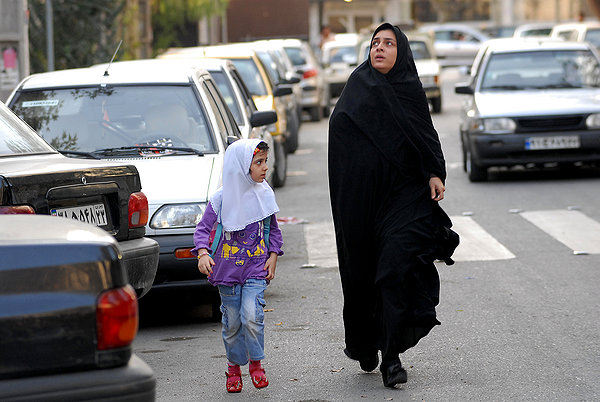
Farhadi always has Razieh and her daughter Somayeh depicted against a wealth of machinery or industry, underscoring the fact that they are part of a class that is not as well-to-do as the people she works for. They are seen as small and insignificant at times in comparison to the larger Iranian area which is bustling with activity. But Razieh is always very watchful of Somayeh and, in turn, Somayeh seems to be equally as watchful of Razieh. In certain shots, such as this one, it almost seems that the role of mother/daughter is reversed and Somayeh has been charged with the care of her mother and not vice/versa.
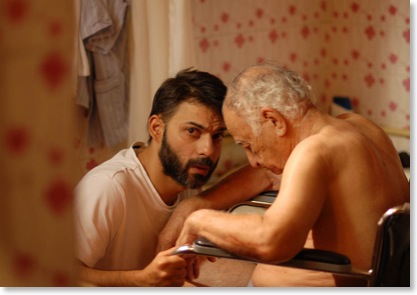
A Separation focuses on many different relationships being revealed for what they are and still others coming undone. Within the limits of this film, Nader shows how deep his relationship with his father is, again emphasizing the film's high level of concentration on the parent-child connection. While the primary parent-child examples are with children who have yet to reach maturity, this relationship is with a parent who has reached maturity and is on his way out. Farhadi underscores the intensity of feeling that Nader has for his father by frequently shooting the two of them together in tight, closed spaces, similar to this bathroom. Others include a doctor's office, the car and his father's bedroom. What this ends up doing is increasing the intimacy and attachment that Nader clearly has with his father, even if, as Nader's wife Simin says, "He doesn't even know who you are."
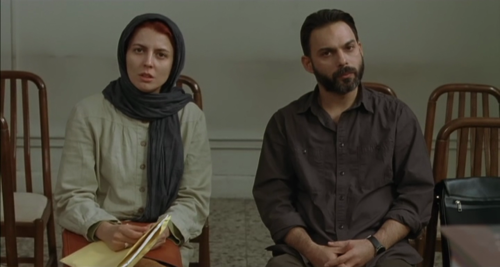
The film opens with this scene of direct address and invites the viewer to "participate." By the end of the scene, the relationship between Nader and Simin has become clear, but so has the political and legal climate under which the remainder of the film will operate. While many of their other scenes together involves some kind of variation on this discussion of their relationship, none of the rest of them are shot straight to the audience. While this shot may seem to have been intended to establish Nader and Simin's relationship, it was actually constructed so that the audience could have a working understanding of the legal world at play within the film. In a sense, it is almost its own character. This two-shot is actually a two-shot of the viewing audience and the Iranian justice system that Farhadi is exploring within A Separation.
Thinking about A Separation got me thinking about other foreign films, due to the way that children and the relationships with children were of such high consequence in this film. Within the confines of this film, children were the one thing that were held above almost anything else, aside from religious traditions and the Qur’an. As discussed, this was exhibited in the way they were shot and the way their characters were constructed as well. But this is not a purely Iranian filmic function. In fact, a high respect for children seems to be very traditional to films that were not made in the United States.
From Bicycle Thieves (Vittorio di Sica, 1948) to Fanny and Alexander (Ingmar Bergman, 1982) and beyond, children have been celebrated in foreign cinema. That celebration may take on different forms (I wouldn’t call Edmund’s experience in Rossellini’s Germany Year Zero much of a “celebration” but he is still a remarkable protagonist, nonetheless), but the idea that children can function as fully-fleshed out characters in a diegetic context is something that is not new to the foreign film circuit.
With some exceptions, the American film world has insisted on portraying the under-12 set as a bunch of fun-loving idiots who just “wanna have fun.” These kids will eventually grow up to be the Tall, Dark and Handsomes that we jettison onto the silver screen, is the thought process. That’s all fine and good, but please note that we also are the film industry that began the Killer Kid genre. So, while I love the hell out of The Bad Seed (Mervyn LeRoy, 1956), The Omen (Richard Donner, 1976) and Orphan (Jaume Collet-Serra, 2009), we should be thinking more critically about this. I would argue just as hard as the next gal for the rights of Killer Kid films to exist, but depictions of children are quite real and quite dangerous. More importantly, as part of our media, they are also quite provocative.
If Forbidden Games (Rene Clement, 1952) doesn’t break your heart, I’m pretty sure that you don’t have one to break. Like Rossellini’s Germany Year Zero, this was a direct reaction to World War II. Clement, who had just had quite reasonable success with his French Resistance film in 1945, La Bataille du rail, was not quite finished with the subject matter. Then again, in 1952, Europe hadn’t quite recovered fully from the war, financially or psychologically.
Using children to investigate the horrors of war was something that many European artists did, either through literature (The Tin Drum by Gunter Grass, published in 1959, then filmed by Volker Schlondorff) or filmic means. The anti-war slogan “War is not good for children and other living things” was practically created by post-WWII cinema in Europe. Forbidden Games is still highly effective on every level it was intended for, and probably several more. Clement used the idea of the war orphan, something that, by that time, had become as commonplace as breathing, and used it as the method through which to tell his story and voice his message.
The idea that “children won’t understand” is a myth. When Paulette and Michel have a conversation about her parents’ death, she may not be able to comprehend the idea that it was a Nazi-air-raid that killed her parents, but in their conversation she is the one who puts two-and-two together. Michel does not have to inform her of her parents’ demise, Paulette just renegotiates them on her own terms, making it all the more heart-breaking. “So they are in a hole to keep dry from the rain?” she inquires. Michel nods. No fuss, no big harrowing sit-down. She gets it.
Foreign films seem to place more faith in children than we do. It’s rather unfortunate. One of the best films I’ve ever watched or ever will watch is about an adult having faith in a child. (sidenote: this is also where the graphics for my blog come from and I totally cried when I rewatched this clip before adding it in here!)
Cinema Paradiso (Giuseppe Tornatore, 1988) is another film that goes by Forbidden Games standards: if this doesn’t hit you right where it should, you’re running on empty, buddy. The relationship that this film explores is one that very few films in the world ever have. It portrays an adult who trusts a child to be smart and talented and never treats him as anything less than that. One other thing of note- although this film was released in 1988, the story being told starts within a flashback that begins just after WWII. Once again, the trope of post-war Europe and its various parts plays an awfully big role in Cinema Paradiso.
There are many, many more to be looked at and discovered. Plenty more that I have not encountered, I am sure. But I still find it puzzling that we have only recently begun to utilize children within our cinema, and I’m still not certain that it is to their advantage. While I enjoyed Little Miss Sunshine (Jonathan Dayton, Valerie Faris, 2006) quite a bit, that was still not the central protagonist role that I believe that children are capable of playing.
Perhaps it is too late for us. Perhaps we are too corporate of a country to develop anything more than Toddlers and Tiaras, a show certain to produce more antisocial personality disorder than you can shake a stick at. Perhaps we do have to leave it to incredible films like A Separation to show us that children are still able to function as powerful positive figures within the cinematic spectrum. I’m not sure. Either way, I think it’s important that we remember that the world hasn’t always been about Firestarter (Mark L. Lester, 1984) and Audrey Rose (Robert Wise, 1977). Sometimes it’s just been about Pather Panchali (Satyajit Ray, 1955) and The 400 Blows (Francois Truffaut, 1959).

